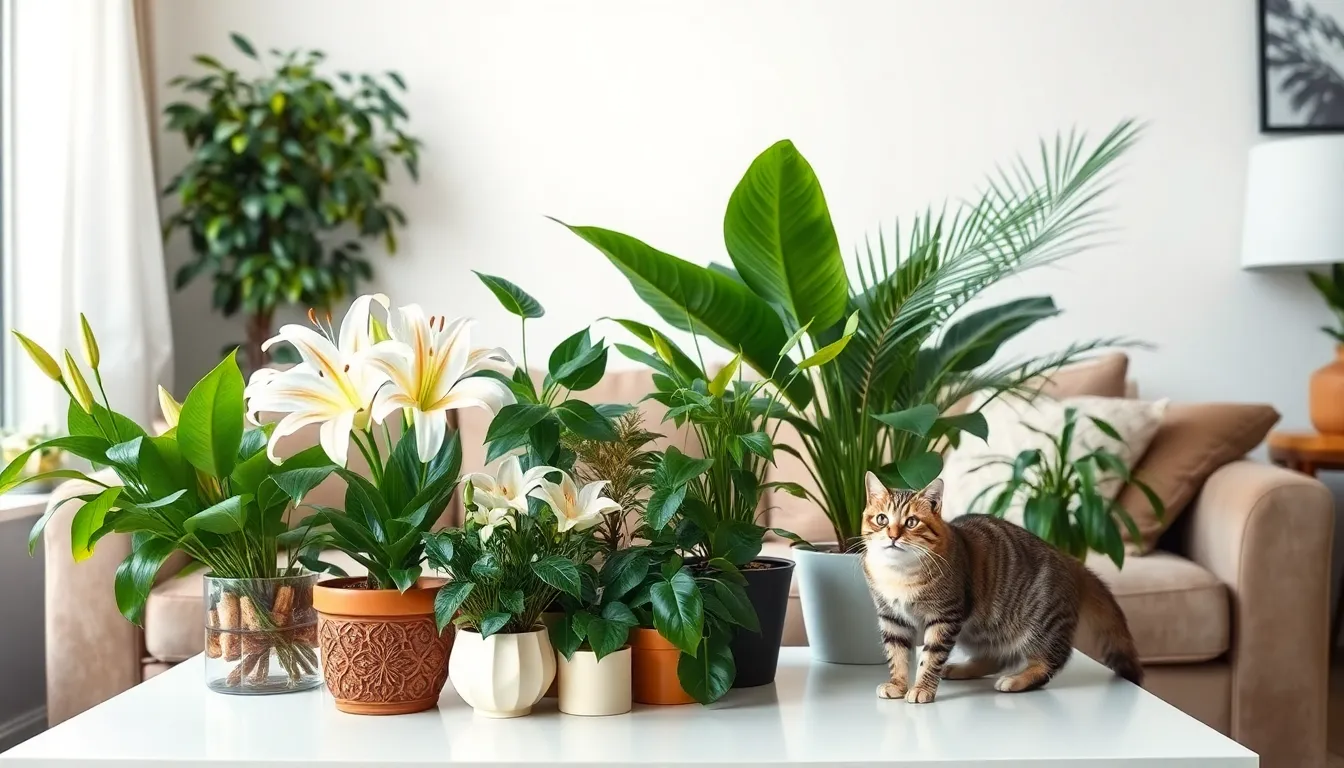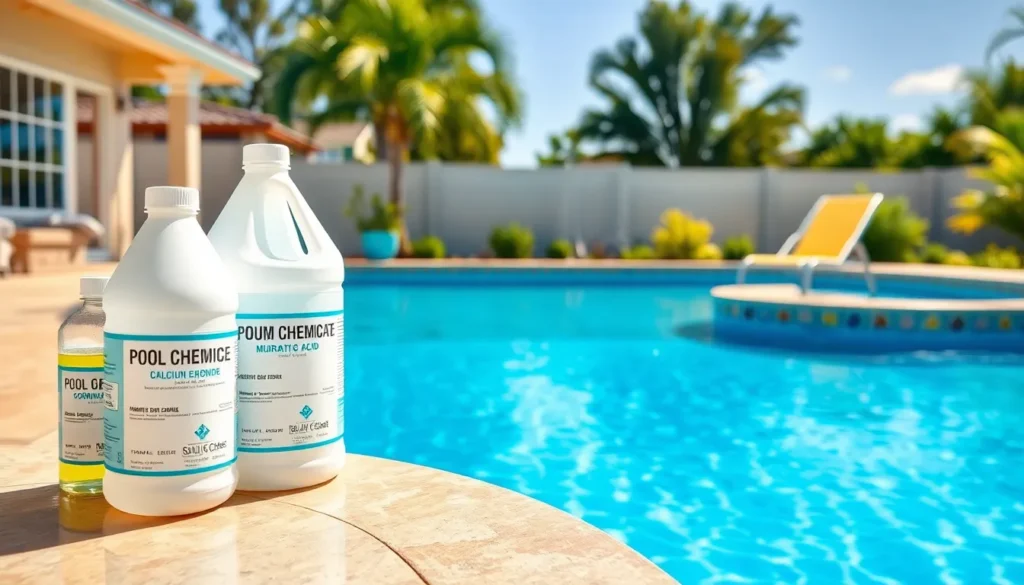Table of Contents
ToggleCats are curious creatures, often treating houseplants like their personal jungle gym. But while they’re busy investigating leaves and knocking over pots, some plants can pose serious risks. It’s a cat-astrophe waiting to happen! Knowing which plants are toxic to feline friends can save both their nine lives and your sanity.
Imagine your cat eyeing that gorgeous peace lily like it’s the latest catnip craze. Little do they know, it’s not just a pretty face; it’s a potential health hazard. This article dives into the world of houseplants that are no friend to your furry companion. With a sprinkle of humor and a dash of knowledge, it’ll help you keep your home safe and your kitty happy. Because let’s face it, no one wants to spend their evening at the vet instead of curled up on the couch with their purring pal.
Overview of House Plants Poisonous to Cats
Certain house plants pose significant risks to feline health, requiring awareness from cat owners. Popular species, such as the peace lily, contain calcium oxalate crystals and can cause oral irritation, excessive drooling, and vomiting. Many other common plants, like philodendrons and pothos, share similar toxic properties. Cats that consume parts of these plants may experience gastrointestinal distress, leading to more serious health concerns.
In addition to peace lilies, some house plants known for their toxicity include dieffenbachia and caladium. Dieffenbachia, also called dumb cane, can result in swelling and pain in the mouth, while caladium can lead to similar symptoms. Owners must recognize the signs of plant poisoning, including lethargy, difficulty breathing, or abnormal behavior.
Toxicity levels vary by plant, and some can be fatal if ingested in large quantities. For instance, the sago palm ranks among the most dangerous house plants, containing cycasin, which causes liver failure in cats. Awareness plays a crucial role in creating a safe home environment for pets, and familiarity with these plants helps reduce exposure risks.
Taking precautions can minimize potential accidents. Keeping poisonous plants out of reach or opting for cat-safe alternatives, like spider plants or bamboo palms, demonstrates responsibility. Knowing which plants to avoid protects felines and promotes a harmonious living space for both pets and their owners.
Common Poisonous House Plants

Certain house plants can pose significant risks to feline companions. Identifying these plants ensures a safer environment for cats.
Lilies
Lilies rank among the most toxic plants for cats. Ingestion can lead to severe kidney failure. Signs of lily poisoning include vomiting, lethargy, and loss of appetite. Immediate veterinary attention is critical if a cat consumes any part of a lily plant. Even small amounts can be dangerous, so ensuring lilies aren’t within reach is vital.
Pothos
Pothos contains calcium oxalate crystals that can irritate a cat’s mouth and throat. Symptoms include drooling, vomiting, and difficulty swallowing. Exposure to this plant can result in gastrointestinal discomfort. Keeping pothos out of reach can prevent unwanted exposure. Awareness of its dangers helps cat owners make informed decisions about their indoor plants.
Philodendron
Philodendron also poses risks due to its calcium oxalate content. Cats may experience oral irritation, vomiting, and swelling of the tongue. Observing these symptoms requires quick action, as they can escalate in severity. These common house plants can be found in many homes, making it crucial to handle them cautiously. Opting for feline-friendly alternatives minimizes health risks.
Sago Palm
Sago palm is extremely hazardous for cats, with all parts of the plant being toxic. Consumption can lead to severe liver failure, which can be fatal. Symptoms may present as vomiting, diarrhea, and lethargy after ingestion. Seeking veterinary assistance immediately can be lifesaving. Owners should consider removing sago palms from their homes entirely to ensure their pets’ safety.
Symptoms of Plant Poisoning in Cats
Identifying symptoms of plant poisoning in cats is essential for timely intervention. Common signs often involve gastrointestinal distress and neurological effects.
Gastrointestinal Issues
Vomiting frequently occurs in cats that ingest toxic plants. Diarrhea also commonly presents alongside vomiting, indicating digestive upset. Excessive drooling may follow, resulting from oral irritation caused by the plant’s harmful compounds. Abdominal pain can occur, often noticed through changes in behavior such as hiding or unwillingness to eat. Cats exhibiting these gastrointestinal symptoms need immediate veterinary attention to address potential dehydration and further health issues.
Neurological Symptoms
Neurological symptoms manifest in various ways when cats ingest poisonous plants. Disorientation often surfaces, confusing the cat and causing unusual movements. Tremors may develop, indicating severe distress. Increased heart rate can accompany these signs, reflecting the body’s reaction to toxins. These symptoms require urgent veterinary evaluation to mitigate any long-term effects caused by the ingested plant. Recognizing these neurological signs can significantly improve the outcome for the affected cat.
Preventive Measures for Cat Owners
Cat owners can take several steps to create a safer environment. Identifying and removing toxic plants from the home constitutes one of the most effective measures.
Safe Plant Alternatives
Cat owners should consider non-toxic plants as alternatives. Spider plants provide a safe option that is also easy to care for. Boston ferns thrive indoors and pose no threat to felines. Additionally, prayer plants and calathea species are both beautiful and safe for cats. Their vibrant colors add aesthetic appeal without compromising pet safety. By incorporating these safe plants, owners can ensure their cats remain healthy and happy.
Cat-proofing Your Home
Cat-proofing the home involves practical measures to reduce risk. Placing plants on high shelves or in hanging pots limits access for curious cats. Creating designated cat areas can divert their attention from harmful plants. Using barriers like decorative screens or plant stands also provides protection. Regularly monitoring the environment prompts immediate action if any harmful items are present. Prioritizing cat safety while enjoying home decor leads to peace of mind for pet owners.
Creating a safe home for cats involves understanding the risks associated with certain houseplants. By being aware of which plants are toxic and recognizing the signs of poisoning, cat owners can take proactive measures to protect their furry companions. Choosing non-toxic alternatives and implementing cat-proofing strategies can significantly reduce the chances of accidental ingestion. With a little care and attention, it’s possible to enjoy the beauty of houseplants while ensuring a safe environment for beloved pets. Prioritizing pet safety not only enhances peace of mind but also fosters a harmonious living space for both cats and their owners.




